
views
Getting in Position
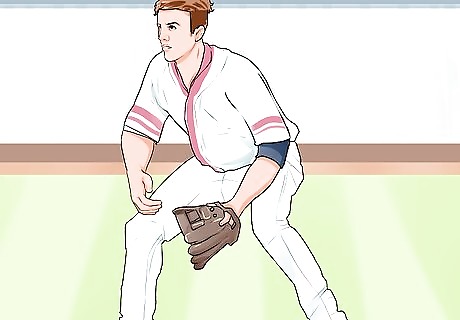
Assume your "baseball ready" position. Before the pitch is even thrown, you should be standing a ready position. Stand on the balls of your feet with your knees slightly bent and your glove in front of you. Focus on your attention on the batter. As the batter strikes the ball, keep your eye on it the entire time.
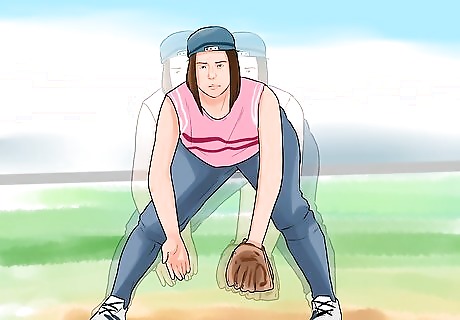
Be ready to move if the ball comes toward you. You'll only have a few seconds to react once the ball is hit, so you've got to be able to reflexively move toward the ball if its yours to field. Some fielders find it helpful to sway from side to side a bit as they wait for the hit. Shifting your weight back and forth can help you feel ready to spring toward the ball quickly.
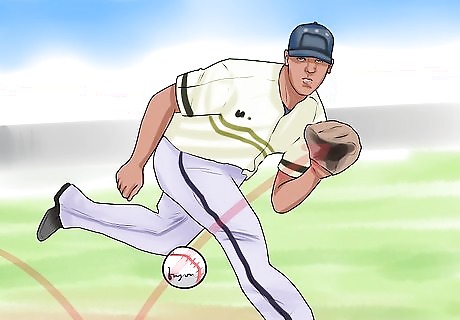
Move in front of the ball. When the ball is hit, run as fast as you can to get in front of it. The angle at which you run is dependent on how fast the ball is moving. Here are a few different scenarios: If it's a slow moving ball, you might want to charge it. This means running toward the ball at an angle that will help you reach it as quickly as possible. If the ball is hit hard and low, it will respond violently to imperfections on the ground. Reaching the ball as quickly as possible is a good way to prevent it from bouncing away from you or at you in a harmful, unexpected way. If it's a very fast moving ball, it's more important to run at an angle that will give you time to field the ball with ease, rather than having to dive or stretch your glove at an odd angle. Instead of running toward the ball, run to one side or the other so you can get in position to have the ball coming right at your glove. With practice, you'll be able to discern what approach is right for what grounder speed. Timing is everything when it comes to fielding grounders.
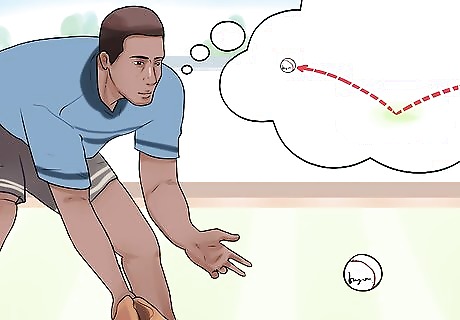
Decide to field it on a long hop or a short hop. Grounders can be difficult to field because each hop they take can make them bounce in an unpredictable direction. Your best bet is to try to field a grounder on as long a hop as possible, because you'll know just where to position your glove to catch it. Fielding a grounder on a short hop is more difficult, because you have less time to react to the ball's bounce. If you let it bounce right in front of your glove, it could easily hop over your shoulder or to your left or right, forcing you to fumble. Try to time your fielding so that the ball won't hop right in front of your glove. Catch it after it has hopped several feet away, so you have time to move toward it and catch it. If the ball does hop right in front of you, you'll need to have very quick reflexes to catch it. Keep your body in front of the ball. If it skips off your glove, you might be able to stop it with your foot or another body part - anything to keep it from getting past you!
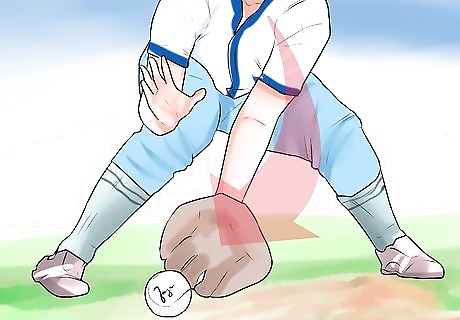
Angle your body to field it more easily. It's most comfortable to field the ball on the same side of your body as your glove hand. If your right hand is your glove hand, try to position yourself so that the ball is moving slightly toward your right side. If your left hand is your glove hand, position yourself so you can catch it on that side. You should still be fairly square with the ball, however. Try to not to put yourself in the position of needing to dive or stretch your arm to catch it. If the ball is traveling extremely fast, you won't always have time to get in the ideal fielding position. You may need to dive, stretch, or backhand it to make the catch.
Fielding the Grounder
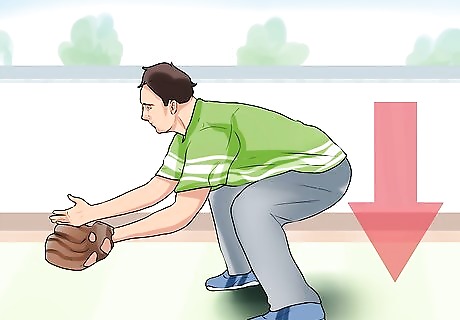
Bend your knees and drop your behind to the ground. When the ball is high, it's time to get low. If you don't, you stand a very good chance of having it fly between your legs - the most embarrassing fielder's error. Drop into a crouch that'll let you move quickly if you need to catch the ball on a short bounce.
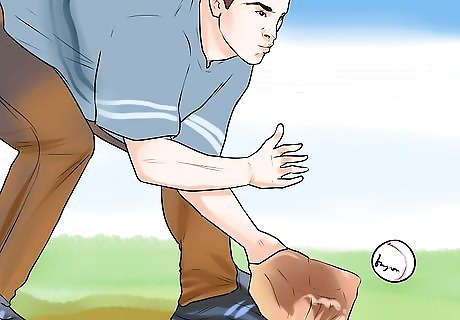
Extend your glove in front of you. Here's where hand-eye coordination comes into play. Extend your glove toward the ball, keeping your elbow slightly bent. Position your glove so that the ball will roll or hop right into it. A common mistake fielders make is not keeping their glove down. It is easier to bring the glove up than to get it down quickly, so keeping your glove in a low position provides better coverage.
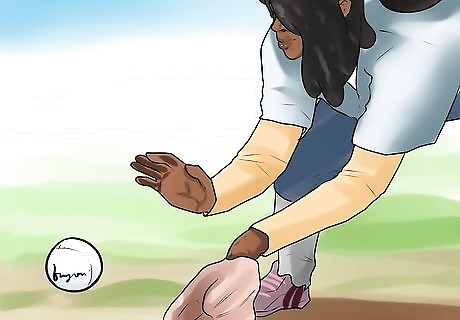
Keep your other hand close. Make sure it's not in the path of the ball, but it should be close enough that you can easily employ it if need be. Two hands are better than one, so your other hand should be ready to trap the ball when it meets your glove.

Watch the ball into your glove. The number one rule in baseball, keep your eye on the ball, applies as much to fielding as it does to hitting. Make sure to watch the ball until it's safely nestled in your glove, and be ready to move if it does something unexpected.

Trap it with your other hand. When the ball is in your glove, close your glove tight and immediately trap the ball with your opposite hand. This puts you in the perfect position to throw the ball where it needs to go as quickly as possible.
Transferring and Throwing the Ball

Transfer the ball to your throwing hand. When the ball is secure, immediately transfer it to your throwing hand. If you used your throwing hand to trap the ball, you can simply grasp the ball using the right grip to quickly throw it. If you fielded the ball with your glove stretched to one side or if you caught it backhanded, bring your glove to your throwing hand and grab the ball. Practice getting a good grip on the ball. Without looking, practice quickly gripping the ball by the seams. Developing this reflex means your throw will more likely be on-target and easy to catch. The ball transfer should be done deliberately and quickly. There's still room for fumbling after you've successfully fielded the ball, so the transfer needs to be practiced just as much. Work on your ball transfer. Practice transferring your ball from your glove to your throwing hand. In the dugout when there's nothing to do, or anytime you have a ball handy, practice.
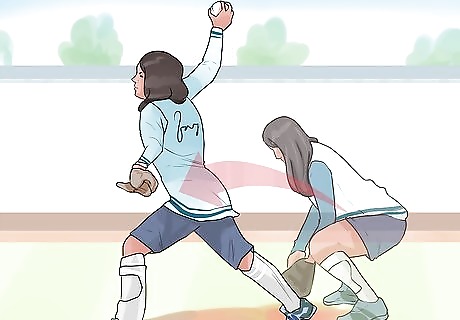
Rise and move to adjust your footing. Now it's time to quickly get in position to throw the ball. Rise up and step forward with your throwing foot, then with your non-throwing foot, then again with your throwing foot as you throw the ball. Doing these steps quickly results in a quick sequence that looks like skipping. It allows you to get your body in the right position to make an effective throw.
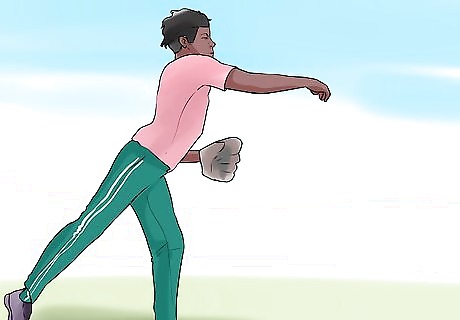
Throw the ball in one fluid motion. After the flurry of fielding the ball, make sure you stay focused enough to make a good throw. A wild throw will completely negate your good fielding efforts. Throw a solid line drive to the appropriate fielder to make a good play. You can also practice throwing from a crouched position, for times when you don't have enough time to rise and do a proper through. In other cases you may need to toss or flick the ball to another fielder.



















Comments
0 comment